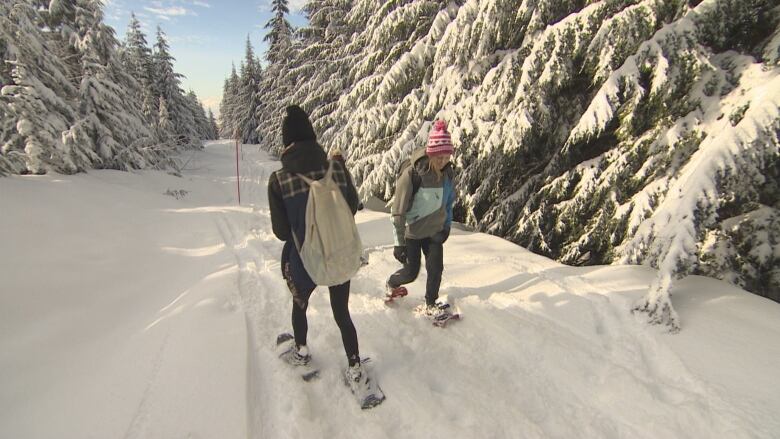8 tips for staying alive in the wintry wilderness
Heading out for a winter adventure in the mountains? Read these tips from North Shore Rescue first.

Perhaps you unwrapped anew pair of snowshoes that was under the Christmas tree, or maybe you're just using your time off to get outside and enjoy the mountains around Vancouver.
Either way, it can be a great time to get outside, but also a time of year when the risks associated with the wilderness are many slipping, falling, getting on the trail afterthe darkor becoming hypothermic are all things that can end in tragedy.
According to North Shore Rescue (NSR)team leader Mike Danks, this time of year can get busy for search and rescue crews, but there are some great steps to take before, during and after you set foot on the trail.
1. Research area beforehand
Weather, snow and avalanche conditions change fast.
Dankssaid it might not always be obvious which areas areoff-limits, but researchingwho the landowner is online (through Metro Vancouver, B.C. Provincial Parks, etc.) can reveal hazards and closures. Dankspointed out that the Hanes Valley Trail, for example, is shut down, and others can be too dangerous to tread on as well.
"We've had a lot of peoplethat venture up [to Hanes Valley]and unfortunately have not returned," said Danks. "Just be very aware what areas are closed and stay away from them, because they're closed for a reason."
2. Get training and buddy-up with an experienced friend
This is especially important when it comes to avalanche training, but even if you're going for a mellow snowshoe adventure, it helps to bolster your own experience with that of someone who has spent more time doing the activityand knows how to use the equipment.

3. Share your route plan
Create a route plan and share it with a friendwho knows when you expect to return. If you need rescuing, that can dramatically cut down on the time it takes search crews to find you.
4. Pack for the trip
According to Danks, winter adventures require specialized gear,in addition to the 10 essentials that you would take on any backwoods trip.
"You need to have avalanche safety equipment with you, such as a transceiver, a probe and a shovel. Those are going to be an absolute necessity," he said, adding that micro-spikes for your boots and an ice axe can sometimes be required.
Danks said that with very early sunsets, people should always pack a good headlamp with a spare set of batteries.

5. Don't count on your cellphone
"Keep in mind that you're not going to have a cell signal. So that's where we really stress that peoplehave a satellite device whether that's a Spotor aDelorme InReach," said Danks.
Some local trails around Vancouver will have decent cell service, but Danks said even accessible, nearby areas like Lynn Headwaters havezones where cellphones won't work.
6. Watch for hazards
Avalanches, tree wellsand slippery ice are to be expected in the mountains, but on the South Coast, Danks highlights the risk of fast, heavy stream flows.
He pointedout that water levels can rise during your trip, so if you cross a stream, make sure you'll be able to get back across on your return trip.
And streams can be a hazard for pets, too, so Dankssuggests keeping dogs on-leash near the water.
7.What to do if you get injured
NSR gets called out to dozens of medical calls each year an injury is a great way to get into a potentially life-threatening situation in the woods.
Hopefully somebody in your party has first aid training, but if the injured person can't walk themselves out of the woods, don't hesitate to call for help.
"We really encourage people to call for help early," saidDanks. "It could be a fire or search and rescue response."
Getting a rescue started early means a much lower chance of things stretching out past nightfall something that can result in a very cold night spent on the mountain.

8. What to do if you get lost
The old saying is "hug a tree," i.e.stay put and wait for search crews to find you, but Dankssaid in some cases, it's actually smart to backtrack until you locate the trail it just depends on the situation.
But, Dankssaid the wrong thing to do is to continue downhill in hopes that you'll find your way off the mountain. That can lead to a tricky situation in a drainage ravine, where a creek could be a problem and cell service may be bad.
And if you're lost, don't hesitate to call for help.
Bonus tip: Save search crews needless hassle
If you're leaving your car at the trail head overnight for some reason, leave a note.
Danks said otherwise, crews will spend the night on a wild goose chase in the woods, thinking someone's lost, when you're safe at home.
Danks said the notedoesn't have to be on the dash for potential thieves to see if you put it somewhere inside, authorities will find it when they investigate.
Follow RaffertyBaker on Twitter: @raffertybaker












_(720p).jpg)


 OFFICIAL HD MUSIC VIDEO.jpg)
.jpg)



























































































